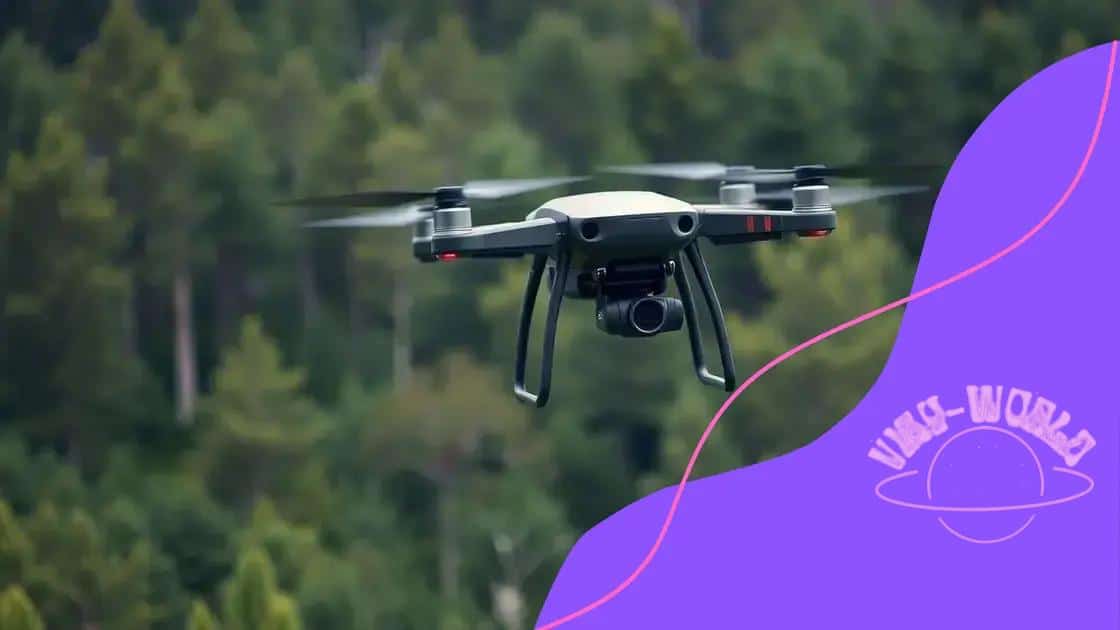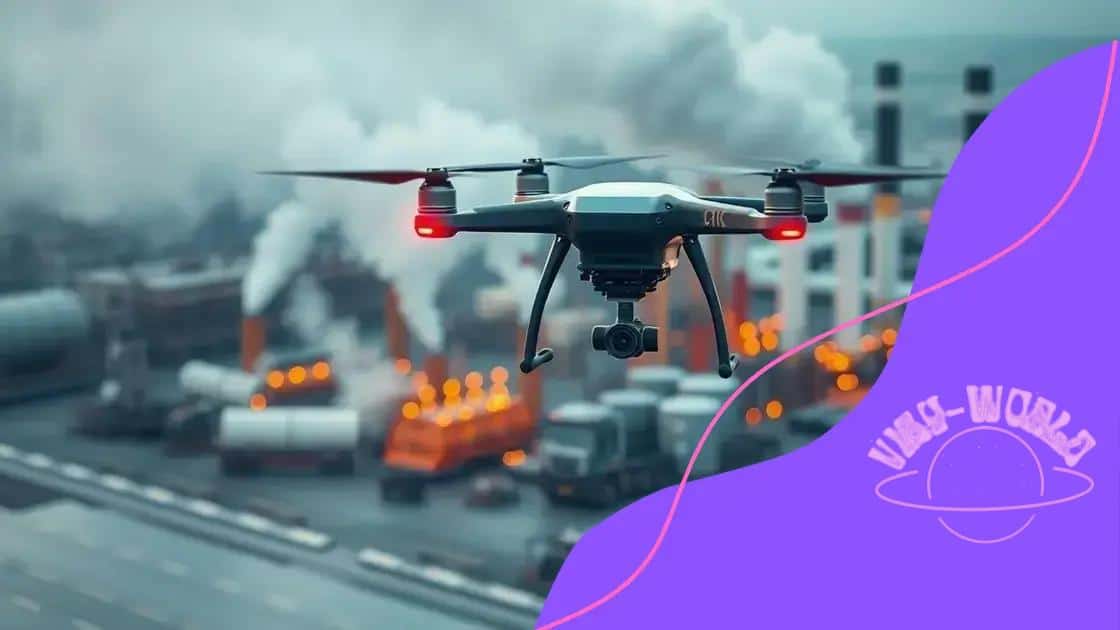Drone innovations in environmental protection

Drones innovations in environmental protection enable efficient wildlife monitoring, pollution tracking, and marine conservation, utilizing advanced technology for real-time data collection and enhancing our ability to address environmental challenges.
Drone innovations in environmental protection are changing the game in how we approach sustainability and conservation. Imagine having the power to monitor vast ecosystems from the sky—what could that mean for our planet?
How drones enhance wildlife monitoring
Drones are revolutionizing wildlife monitoring. These amazing machines provide an aerial view that traditional methods simply cannot offer. With drones, researchers can capture detailed images and data without disturbing wildlife, leading to more accurate observations and insights.
Benefits of Using Drones for Wildlife Monitoring
There are numerous advantages to employing drones in this field. Firstly, they can cover vast areas quickly, collecting data on animal populations and behaviors that would take teams on foot much longer to gather.
- Minimized human disturbance
- Real-time data collection
- Cost-effective monitoring solutions
- Access to hard-to-reach areas
Furthermore, drones equipped with thermal sensors can detect heat signatures, allowing researchers to monitor species that are otherwise hidden from view, such as nocturnal animals or those camouflaged in their environment.
Applications in Conservation
Drones are invaluable in conservation efforts. For example, they can help track endangered species, monitor their habitats, and evaluate the impact of human activities on these vulnerable populations. By providing real-time data, conservationists can make informed decisions to protect these species more effectively.
Moreover, through high-resolution mapping, drones can help identify areas of illegal activity, such as poaching. This data allows rangers to respond quickly to potential threats, safeguarding wildlife in critical regions.
In conclusion, drones have become essential tools in wildlife monitoring, enhancing our ability to observe and protect animal populations while minimizing human impact on their natural habitats.
Using drones for forest conservation
Using drones for forest conservation is becoming increasingly popular. These flying devices facilitate monitoring vast forested areas with minimal disruption to the ecosystem. Drones can capture high-resolution images and videos, providing essential data for conservation efforts.
Key Benefits of Drone Technology
One significant advantage of using drones is their ability to collect data quickly and efficiently. They can fly over areas that are difficult to access by foot, such as remote or rugged terrains. This capability allows researchers and conservationists to monitor changes in forest health over time.
- Rapid assessment of forest coverage
- Detection of illegal logging activities
- Mapping of biodiversity
- Assessment of forest damage post-natural disasters
Additionally, drones can help identify invasive species that threaten native flora. By detecting these invaders early, conservationists can act swiftly to mitigate their impact and protect the ecosystem. Furthermore, drones equipped with thermal imaging devices can provide insights into wildlife activities within the forests, helping to track and protect endangered species.
Real-World Applications
Several projects worldwide have shown the effectiveness of drones in forest conservation. In many cases, conservation groups have successfully used drones to conduct aerial surveys, monitor logging activities, and even plant trees in deforested areas. This innovation not only enhances conservation strategies but also engages local communities in preservation efforts.
Imagine being able to view your forest from the sky, spotting changes and challenges that need attention. With drones, this vision is becoming a reality, offering a new perspective and powerful tools for improving forest management and conservation.
Drones in pollution tracking and management

Drones in pollution tracking and management serve as vital tools for identifying and analyzing environmental threats. These unmanned aerial vehicles are helping researchers and policymakers to gather precise data on pollution sources and their impacts on the environment.
Advantages of Using Drones
The ability of drones to cover large areas quickly makes them invaluable for pollution monitoring. They can collect air and water samples at various altitudes, offering a comprehensive view of pollution levels.
- Access to remote locations
- Real-time data collection
- Reduced costs compared to traditional methods
- Enhanced safety for field workers
Additionally, drones equipped with advanced sensors can identify specific pollutants, such as greenhouse gases or chemical spills. This capability allows environmental experts to respond promptly to contamination incidents, minimizing potential damage.
Real-World Applications
Many municipalities and environmental organizations are using drones for effective pollution management. For example, they can monitor industrial emissions, track wastewater runoff, and assess the health of water bodies. Drones make it easier to visualize pollution patterns and develop strategies for mitigation.
Furthermore, they can assist in monitoring compliance with environmental regulations by conducting inspections of industrial sites, pipelines, and landfills. By using drones for pollution assessment, agencies can gather data that supports better policy decisions, ensuring cleaner air and water for future generations.
The role of drones in marine protection
The role of drones in marine protection is gaining recognition as an innovative approach to safeguard our oceans. These aerial devices are proving to be essential tools for monitoring marine environments and addressing various threats.
Benefits of Drones in Marine Conservation
Drones can survey large areas of water quickly and efficiently, making it easier to gather data on marine life and habitats. They help researchers monitor changes in ocean ecosystems without disrupting wildlife.
- Cost-effective surveillance
- Access to remote oceanic regions
- Real-time data collection
- Support for wildlife protection efforts
Equipped with high-resolution cameras and sensors, drones can collect vital information on coral reefs, marine mammals, and other critical habitats. They are especially useful for tracking the health of coral reefs, which are essential for marine biodiversity.
Applications in Marine Conservation
Many organizations are effectively utilizing drones to combat illegal fishing and protect endangered species. By providing a bird’s-eye view of fishing activities, drones can help law enforcement monitor compliance with fishing regulations.
Moreover, drones are capable of monitoring marine pollution, such as oil spills or plastic debris. They can quickly detect changes in water quality and provide data that supports timely interventions.
Research and conservation projects, employing drones, enhance our understanding of marine ecosystems. The data collected can guide conservation strategies, ensuring our oceans remain vibrant and healthy for future generations.
Future trends in drone technology for environmental work
Future trends in drone technology for environmental work are set to transform how we approach conservation and sustainability. As technology progresses, drones are becoming more advanced, efficient, and accessible for various environmental applications.
Innovations Driving Change
The integration of artificial intelligence (AI) with drone technology is one of the most exciting trends. AI enables drones to analyze data on the fly and make decisions without human input. This can lead to more effective monitoring of ecosystems and faster responses to environmental threats.
- Enhanced data analysis capabilities
- Improved flight autonomy
- Real-time environmental monitoring
- Integration with other smart technologies
Additionally, the use of drones equipped with multispectral and hyperspectral sensors is on the rise. These sensors allow for detailed assessments of vegetation health, water quality, and even soil conditions. This data is crucial for sustainable land management practices.
Cost Efficiency and Accessibility
As drone technology becomes more affordable, its application in environmental work is expanding. Smaller organizations and local communities are increasingly adopting drones for conservation projects. This accessibility helps to democratize environmental monitoring, allowing more people to participate in conservation efforts.
Furthermore, advancements in battery life and solar-powered drones will enable longer flight times and reduced operational costs. This will enhance the capacity for long-term studies and monitoring programs in remote areas.
The future of drone technology is also leaning towards collaboration with citizen scientists. Drones can empower individuals to contribute to data collection and analysis, expanding the reach of environmental protection initiatives.
In conclusion, the use of drones for environmental protection is changing how we monitor and manage our natural resources. As technology advances, drones will play an even more significant role in tracking wildlife, assessing pollution, and supporting conservation efforts. Their ability to provide real-time data and access hard-to-reach areas makes them invaluable tools. The future trends in drone technology hint at greater efficiency, enhanced capabilities, and broader accessibility, empowering everyone to take part in preserving our planet. By embracing these tools, we can work toward a more sustainable and healthier environment.
\n
\n
FAQ – Questions about Drone Innovations in Environmental Protection
How do drones help in wildlife monitoring?
Drones provide aerial views that allow researchers to track wildlife populations without disturbing their habitats.
What benefits do drones offer for pollution tracking?
Drones can collect real-time data on air and water quality, helping to identify pollution sources quickly.
How are drones used in marine protection?
Drones monitor marine life, assess coral health, and detect illegal fishing activities, supporting conservation efforts.
What future trends can we expect in drone technology?
We can expect enhanced AI integration and increased accessibility, making drones more efficient and affordable for conservation purposes.





